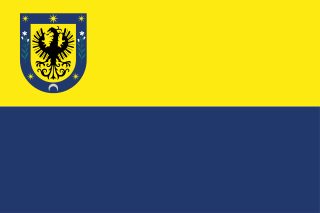
Concepción is a city and commune in south-central Chile, and the geographical and demographic core of the Greater Concepción metropolitan area, one of the three major conurbations in the country. It has a significant impact on domestic trade being part of the most heavily industrialized region in the country. It is the seat of the Concepción Province and the capital of the Bío Bío Region. It sits about 500 km south of the nation's capital, Santiago.

The Congregation of Holy Cross, abbreviated CSC, is a Catholic clerical religious congregation of pontifical right for men founded in 1837 by Basil Moreau, in Le Mans, France.

Vitacura is a commune of Chile located in Santiago Province, Santiago Metropolitan Region. It is one of the most expensive and fashionable areas of Santiago. Inhabitants are primarily high income families. It belongs to the Northeastern zone of Santiago de Chile.

Lo Barnechea is a commune located in the northeastern sector of the province of Santiago and its area corresponds to 48% of this province. Its urban boundaries are: to the north with Los Andes of the Valparaíso region, to the west with Colina, to the southwest with Vitacura and Huechuraba, to the south with Las Condes and to the east with San José de Maipo. It developed around the old rural town of Lo Barnechea. Its population is heterogeneous, as it is inhabited by high- and medium-high-income families in sectors such as La Dehesa, Los Trapenses and El Arrayán, and also by medium-low- and low-income families, mainly in the towns of Lo Barnechea, Población La Ermita and Cerro Dieciocho.
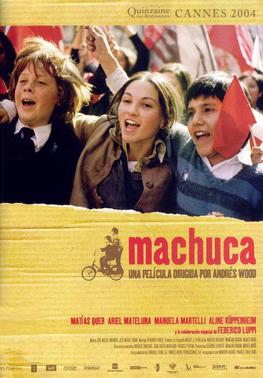
Machuca is a 2004 internationally co-produced coming-of-age drama film co-written and directed by Andrés Wood. It stars Matías Quer, Ariel Mateluna, Manuela Martelli, and Aline Küppenheim alongside Federico Luppi.
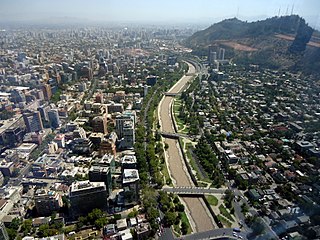
Providencia is a commune of Chile located in Santiago City. It is bordered by the communes of Santiago to the west, Recoleta to the northwest, Las Condes and Vitacura to the northeast, La Reina to the east, and Ñuñoa to the south. It belongs to the Northeastern zone of Santiago de Chile.
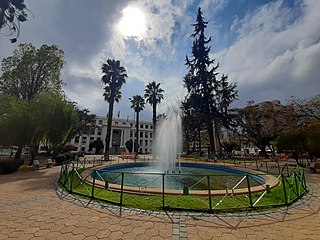
Ñuñoa is a commune located in the Northeastern zone of Santiago, within the Santiago Metropolitan Region of Chile.

Quillota is a city located in the valley of the Aconcagua River in Valparaíso Region, Chile. It is the capital and largest city of Quillota Province. It is surrounded by the communes of San Isidro, La Palma, Pocochay, and San Pedro. It is an important agricultural center, mainly because of the plantations of avocado and cherimoya trees.

Lasallian educational institutions are educational institutions affiliated with the De La Salle Brothers, a Catholic religious teaching order founded by French priest Saint Jean-Baptiste de La Salle, who was canonized in 1900 and proclaimed by Pope Pius XII as patron saint of all teachers of youth on May 15, 1950. In regard to their educational activities the Brothers have since 1680 also called themselves "Brothers of the Christian Schools", associated with the Institute of the Brothers of the Christian Schools; they are often referred to by themselves and others by the shorter term "Christian Brothers", a name also applied to the unrelated Congregation of Christian Brothers or Irish Christian Brothers, also providers of education, which commonly causes confusion.

The Catholic Church in Chile is part of the worldwide Catholic Church, under the spiritual leadership of the Pope, the curia in Rome, and the Episcopal Conference of Chile.

Andrés Wood Montt is a Chilean film director, producer and writer. Some of his most popular films include Machuca, Violeta se fue a los cielos, and Historias de Futbol. He created his own production company known as Wood Producciones in 1993.
Andrés Pascal Allende is a Chilean Marxist dissident and nephew of former President Salvador Allende. He is of Basque and Belgian descent.

Holy Family Academy, also referred to by its acronym HFA, is a private Catholic basic education school administered by the Congregation of the Missionary Benedictine Sisters of Tutzing in Angeles, Pampanga, Philippines. It was established in 1906 as a Catholic parochial school and named Colegio de la Sagrada Familia in 1910. It is now one of the most prestigious schools in Angeles City. It has both elementary and high school departments as well as kindergarten and preparatory school classes for younger students. The school follows the Benedictine tradition of Ora et Labora, which means "Prayer and Work".

Italian Chileans are Chilean-born citizens who are fully or partially of Italian descent, whose ancestors were Italians who emigrated to Chile during the Italian diaspora, or Italian-born people in Chile. It is estimated that about 600,000 Chileans are of full or partial Italian ancestry, corresponding to about 3.5% of the total population, while Italians by birth in Chile are about 52,000. In Southern Chile, there were state-conducted Italian immigrant programs though they were not as massive as the German and Croatian immigrant programs. Families settled especially in Capitán Pastene, Angol, Lumaco, and Temuco but also in Valparaiso, Concepción, Chillán, Valdivia, and Osorno. One of the notable Italian influences in Chile is, for example, the sizable number of Italian surnames of a proportion of Chilean politicians, businessmen, and intellectuals, many of whom intermarried into the Castilian-Basque elites.

The following is an alphabetical list of articles related to the Republic of Chile.
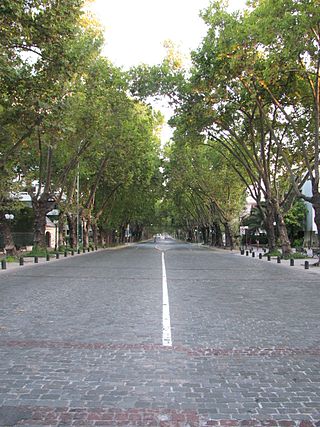
Pedro de Valdivia Avenue is a major north-south avenue on the east side of Santiago, Chile. It is named after Pedro de Valdivia and passes through the districts of Providencia, Ñuñoa and Macul.

Eugenio Cruz Vargas was a notable Chilean poet and painter. His art was developed under the naturalistic landscape and abstraction, and his collection of poems under the concepts of surrealism and culminate in the literary creationism.)

The Lutheran Church in Chile is one of the two denominations of Lutheranism in Chile. It separated from the historical Evangelical Lutheran Church in Chile (IELCH) in 1975 due to differences in political perceptions of the pastors and bishops during the beginning of the military dictatorship led by Augusto Pinochet. It is a member of the Lutheran World Federation, which it joined in 1991. Most congregations are bilingual in German and Spanish.

Line 7 is a new rapid transit line due to open on the Santiago Metro, in 2027. Intended to relieve the busy Line 1, the Line 7 will start in Renca in the northwest, passing through the city center, before ending in the borders of Las Condes and Vitacura in the northeast. Expected to be finished by 2028, it will add 19 new stations and 24.8 km (15.4 mi) of track to the system. Its distinctive color on the network line map is gray. Cost of construction has been set at $2.5 billion USD.























